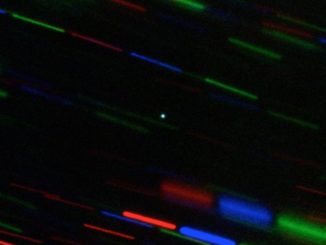
Ten days after a swingby to receive a gravitational boost toward its asteroid target, NASA’s OSIRIS-REx spacecraft turned one of its cameras back toward Earth, resolving its bluish home planet hanging in the void of space accompanied by the Moon.
The MapCam camera on the OSIRIS-REx spacecraft took the composite color image Oct. 2 at a distance of around 3.2 million miles (5.1 million kilometres) from Earth, or approximately 13 times the distance between the Earth and the moon.
The moon appeared just inside MapCam’s field of view, allowing both planetary bodies to appear in the same frame, according to information released by scientists at the University of Arizona, which operates the camera.
MapCam is one of three science cameras aboard OSIRIS-REx, which launched in September 2016 on a two-year journey to asteroid Bennu, an object measuring around 1,600 feet (500 metres) in diameter that regularly comes near Earth. The robotic mission will arrive at Bennu late next year, survey the unexplored asteroid, and then descend to its surface for a touch-and-go maneuver to capture at least 2.1 ounces — 60 grammes — of rock samples for return to Earth in September 2023.
OSIRIS-REx is short for the Origins, Spectral Interpretation, Resource Identification, and Security – Regolith Explorer.
The probe’s Sept. 22 flyby of Earth used the planet’s gravity to slingshot toward Bennu, naturally bending its trajectory without expending precious fuel.

The MapCam camera got a much closer view of Earth just after the Sept. 22 flyby, returning a view of the Pacific Ocean from a distance of 106,000 miles (170,000 kilometres). Australia is visible in the lower left of the image, and Baja California in the upper right.
Scientists also used the Earth encounter to calibrate OSIRIS-REx’s other instruments, which will make measurements of mineral and chemical make-up of Bennu, including a search for organic molecules, the building blocks of life. The results will help guide where the spacecraft picks up the sample for return to Earth.
The mission’s Canadian-built laser altimeter and a student-built dust experiment were not activated during the Earth fly. They will not be fully switched on until arrival at Bennu.
Next up for the mission will be a series of course correction burns over the next year to set up for the final approach to Bennu.
Science observations of Bennu will begin in August 2018, and detailed images of Bennu should be acquired by OSIRIS-REx in October. Analysts will look for evidence of debris or moons in the asteroid’s vicinity before OSIRIS-REx’s arrival.
Email the author.
Follow Stephen Clark on Twitter: @StephenClark1.



